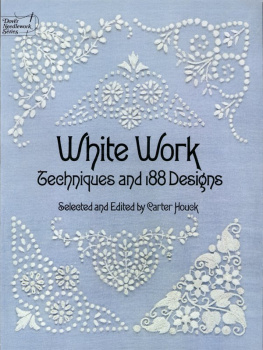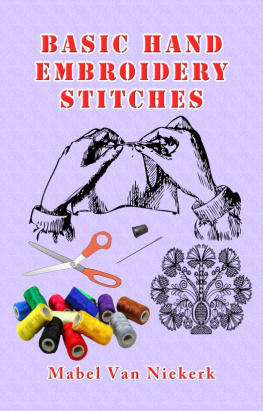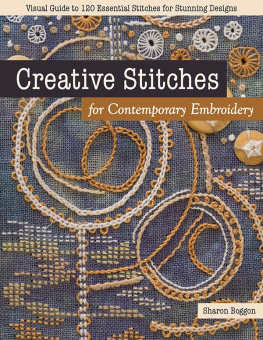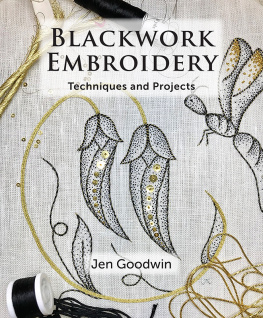WHITE WORK
Techniques and
188 Designs
Selected and Edited by
CARTER HOUCK

Dover Publications, Inc.
New York
Copyright 1978 by Dover Publications, Inc.
All rights reserved.
White Work: Techniques and 188 Designs, first published in 1978, is a new collection of patterns from The Chief Pattern Book of Embroidery Patterns for the Improvement of Artistic Embroidery on Linens and the Promotion of Good Handicrafts, originally published in Nuremberg, Germany by the Johann Merkenthaler Factory (circa 1900). A new introduction has been written especially for this edition.
Library of Congress Catalog Card Number: 78-56767
International Standard Book Number
ISBN-13: 978-0-486-23695-7
ISBN-10: 0-486-23695-1
Manufactured in the United States by Courier Corporation
23695120
www.doverpublications.com
CONTENTS
For most modern women the term White Work brings to mind visions of lacy, intricate pieces of embroidery obviously worked under a magnifying glass and too formidable to contemplate beyond the glass display cases of a museum. This vision is not necessarily true. White Work, which simply means white embroidery on white fabric, has long been a part of the embroidery tradition of many countries around the world. Since there must always be a smooth, even quality to the stitches that makes them blend perfectly with the background, White Work has always been the best way to show ones talent in needlework. Whether the embroidery is composed of a few simple stitches or looks like elegant lace, the techniques are basically the same. Fortunately, a little time and practice with the basic stitches can produce a very fine piece of White Work.
This book is intended as an introduction to the craft of White Work. It contains simplified techniques, stitch instructions and 188 embroidery patterns for White Work. I have chosen mostly those designs which can be worked effectively in raised embroidery using one, two or three types of stitches. I have purposely omitted many patterns that involve open work, pulled thread or cut work because I feel that these techniques are books in themselves. (See Fangel, Winckler and Madsen: Danish Pulled Thread Embroidery , Dover 0-486-23474-6.) The designs are grouped according to the stitches which I feel work best for them. As you become more sure of your technique, you can use other stitches, allowing your imagination to be your guide. The designs are all taken from an early twentieth-century German pattern catalog and were originally intended for White Work.
A BRIEF HISTORY OF WHITE WORK
Probably the oldest known piece that could be called White Work is a Danish braided hairnet taken from a 3,000-year-old grave. From that time to the present, White Work has appeared in many different forms in the cultures of many countries. The endless interchange of types of White Work fabrics and stitches and ways of working often makes it hard to follow the exact progress of any specific variety. For instance, tambour work, one of the most popular types of White Work, can be traced from the East, probably China, to France and England in the mid-eighteenth century. From there it spread over much of Europe and, of course, to America. Today we see a form of it on fine, white muslin blouses and shirts imported from India and Pakistan. It lends itself to long, trailing vines and flowers and magical animals and mystical birds.
True tambour work was so called because it was worked on an odd-looking round frame resembling a drum. The frame had an oval base, rather like half of a huge egg, which rested on the lap, leaving both hands free to work. The basic stitch is a chain stitch, worked very rapidly with a tiny hook. The thread is carried underneath the stretched fabric with the left hand while the right operates the hook in a motion similar to rug hooking. (The chain stitch has one thing in common with many types of continuous stitching, worked either by hand or machine; it can be pulled out even faster than it is worked.) A fine copy of tambour work can be made with a needle by following the directions for chain stitch on page 9 and by using either a hand-held hoop or a standing frame. It is one of the simplest and most effective types of White Work and can be used for all or parts of many of the designs in this book.
Throughout history queens and ladies, little girls, servants and women of the church executed their White Work embroidery on a variety of things and for a variety of reasons. Little girls in many countries and of most social classes were considered uneducated if they could not do a beautiful sampler of stitches by the time they were ten years old. Servants were often hired because of their skill with the needle. A maid probably felt more fortunate to go blind embroidering her mistress dressing gowns than to grow old scrubbing floors. Queens and ladies not only had idle hours to kill but many, like Mary Queen of Scots, probably looked upon their handwork as a principal means of expression. In the church there was an endless need for beautiful ecclesiastical garments and fine, white altar linens, which were produced either by nuns or great ladies. The story is told that Queen Isabella would ride out to battle in the morning at the head of one of Spains armies and sit in her tent at night embroidering beautiful White Work robes for her favorite archbishop.
In the eighteenth century White Work in the form of pulled thread work of such delicacy was produced in Denmark that it often competed with the beautiful laces made in that country. The two techniques used similar designs, and it sometimes takes an expert to tell bobbin lace from pulled thread work, sometimes known as needle lace or embroidered lace.
As the Victorians began to decorate every blouse, cap and fichu of fine, white fabric with fine, white stitches, the competition was on. What started out as sewed muslin, using a few easy stitches, was pushed out of popularity by Venetian embroidery or French embroidery or Ayrshire work of increasing complexity. In the middle of the nineteenth century one of the most long-lasting types of White Work, called broderie anglaise, entered the competition. It is a relatively simple cut work, with no intricate needle lace worked in the openings. We now know it as Madeira work, usually embroidered in pale blue thread on fine, white linen, using only satin and buttonhole stitches.
From mainland Europe, all kinds of needlework traveled the world over in the age of expansion and colonization. It may have been taken on purposeas in the case of Madeira workto fill an economic need or to create an industry. Incidentally the thread was changed from white to pale blue in the migration from England to Madeira because the blue stood up better in the more tropical climate which tended to yellow a pure white thread.
In many other cases the work changed over the years, finally taking on the native characteristics of the new lands. The Dutch took White Work to South Africa where some of the finest and most intricate is still worked. The people of the Philippines, with their mixed cultural heritage, produced beautiful White Work with a special appearance gained from the use of their own very suitable pia, a sheer even-weave pineapple cloth. No one would dare travel to the Philippines and not bring back the beautiful mens shirts or ladies handbags of this cloth, delicately decorated with lacy white embroidery.
White Work was extremely popular in America through the Victorian era and on into the twentieth century. Young ladies were taught to embroider handkerchiefs at an age that we would now consider unthinkable. By the time the camera came along fewer intricate lace and open-work stitches appear in the blouses, collars and cuffs that we see in early photographs of American women, but many other types of White Work are in evidence. Feather stitchsingle, double, ad infinitumwas one of the most popular White Work stitches, and many exquisite christening gowns were worked entirely in satin stitch, stem stitch and French knots.
Next page







